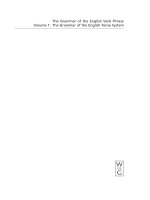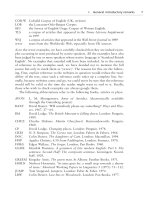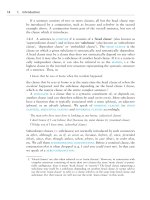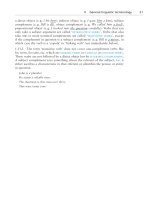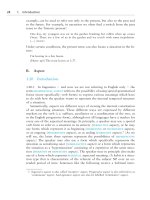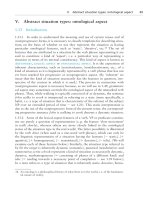English Verb patterns
Bạn đang xem bản rút gọn của tài liệu. Xem và tải ngay bản đầy đủ của tài liệu tại đây (12.89 KB, 1 trang )
Verb Patterns
A transitive verb
is one that has an object. The normal order of words in an English sentence is
subject + verb
+ object.
Alice likes sweets. (Subject – Alice, Verb – likes, Object – sweets)
The principal punished the boy. (Subject – principal, Verb – punished, Object – boy)
The monk burned himself. (Subject – monk, Verb – burned, Object – himself)
Alice likes …what? Sweets
The principal punished …whom? The boy
The answer to the question
what
or
whom
is the direct object. Notice also the use of the reflexive pronoun (e.g.
myself, himself, herself, themselves etc.) as an object in the third sentence.
Subject + verb + object + adverb particle
Some verbs are followed by adverb particles. Examples are: put on, take off, give away, bring up, call in etc.
Sometimes the particle is detached from the verb and put after the object.
He t
hrew
it
away.
They
called
the visitor
in.
He
put
his coat
on.
His grandmother
brought
him
up.
You must
send
it
back.
Note that the particle is put after the object when the object is a personal pronoun or when it is comparatively
short.
The difference between an
adverb particle
and a
preposition
is that while the particle is closely tied to its verb,
the preposition is closely tied to the noun or pronoun which it controls. The following are used only as adverb
particles and never as prepositions –
away, back, out, backward, forward, upward, downward
etc. But
on, off,
in, up, down, to, from
etc., are used as particles and prepositions.
When the object is long or when it has to be made prominent, the adverb particle comes before the object.
The chief guest
gave away
the prizes.
He
put on
an air of innocence.
The sailors
put out
the fire in the hold of the ship.
We will not
throw away
anything useful.
Be first to know when grammar rules change! Sign up to our newsletter here: englishgrammar.org (It's free)
Powered by TCPDF (www.tcpdf.org)
